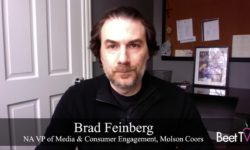Television viewing habits are undergoing a significant shift as younger consumers gravitate toward newer digital platforms while older generations show greater loyalty to linear TV. Amid these trends, the advertising market is being shaped by the demands of disruptor direct-to-consumer (DTC) brands that seek to generate sales even as they raise brand awareness.
“Those three things are creating very different dialogue depending on who you’re talking to, and putting it together is an interesting project,” said Peter Olsen, executive vice president of ad sales and content partnerships at A+E Networks.
In this conversation with Tim Sprengler, general manager of advanced TV solutions at marketing technology company Amobee, Olsen shared his thoughts about consumer trends and the changing media landscape as the network prepares for the yearly upfront sales season. He said advertisers are looking for a unified view of consumers, which is challenging amid the changes in viewing habits.
“Bringing it back to a media plan and bringing it back to single-source measurement is very frustrating to people,” Olsen said. “We’re looking for companies like Amobee to help unite the industry, for the lack of a better word.”
Like other programmers, A+E has seen a generational shift in viewing habits. The median age of linear TV is 55 and older, while its owned-and-operated digital apps mostly appeal to viewers in their mid-40s and its connected TV channels are popular with consumers in their mid-30s.
“We can hypertarget more on the digital and CTV platforms,” Olsen said, adding that A+E can help advertiser reach audiences across a broad spectrum of programming and viewing devices.
Looking at the growing role of consumer data in audience targeting, Olsen said it’s important to recognize that advertisers ultimately are looking for ways to boost sales and see a strong return on their investments in media.
“There is a bit of an overload with data right now, and an underload of technology to solve the problem,” Olsen said. “There’s a lot of solutions being presented, but what’s the problem they’re trying to solve?”
A+E several years ago began offering guarantees to advertisers that demanded measurable business outcomes.
“We’ve always known that television advertising works,” Olsen said, citing examples where buseinesses see higher foot traffic or sales growth.
The growth of DTC brands has spurred discussion about whether marketers can build a brand while also selling a product. Olsen said he said he doesn’t see too much conflict between the priorities of upper-funnel brand-building and lower-funnel final sales.
“I don’t think the funnel has collapsed. The lower, middle and upper all coincide in the world we’re in,” Olsen said. “Consumers are able to understand a brand and its essence faster than ever.”
As media companies develop more first-party data about consumers and their viewing habits, they’re coming to resemble “walled garden” platforms like social media, internet search and e-commerce companies that have deep troves of data. Olsen sees an opportunity to thrive by partnering with advertisers who also have their own sources of data.
“You can win in that landscape even if you’re not the biggest garden player or the biggest gardener,” Olsen said. “You can actually play off the trends and all the learnings you’re getting from all these partners.”
Upfront sales have become a bigger source of debate as many advertisers push for a buying schedule based on the calendar year, and seek greater flexibility in their media buys. That includes a bigger push into programmatic advertising that allows for more audience-based targeting.
Olsen sees a need for the upfront, despite the growth in programmatic advertising, though “there will be more automation and more data-driven decision-making,” he said.
You are watching “Optimizing a Rapidly Converging TV & Video Marketplace: What’s Next,” a Beet.TV leadership series presented by Amobee. For more videos, please visit this page.










































